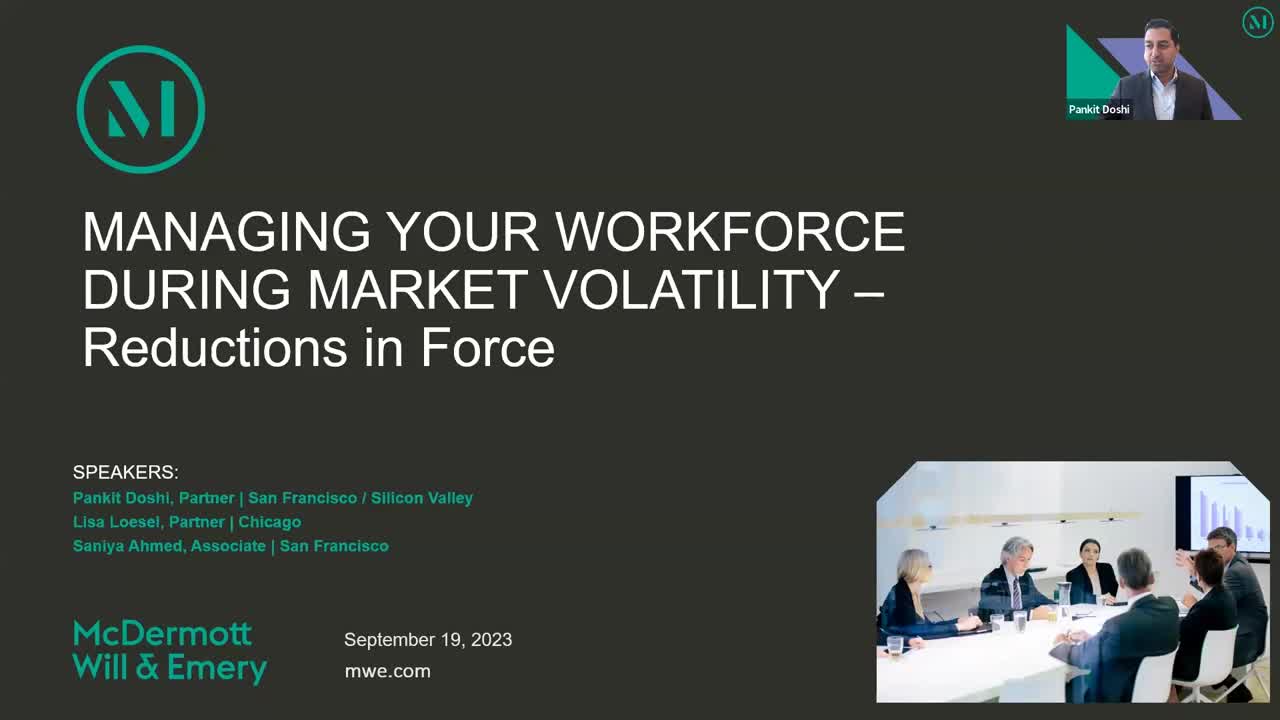Overview

Market volatility and other business disruptions can force employers to make difficult personnel decisions around reductions in force (RIFs). These may include reducing employee headcount, eliminating entire departments, hiring independent consultants or implementing hiring freezes to ease potential financial burden.
During this webinar in our series exploring best practices for workforce management in volatile markets, Pankit Doshi, Lisa Loesel and Saniya Ahmed offered strategies to follow when making restructuring decisions.
Top takeaways included:
- Consider your options before conducting a RIF. There are various cost-saving options employers can consider prior to layoffs, including hiring, promotion or transfer freezes, furloughs, reduction of hours, pay reductions and voluntary reductions. Employers seeking to implement a hiring, promotion or transfer freeze are encouraged to abide by the ban to the extent possible and have justifiable business reasons for any exceptions. Furloughs, also known as mandatory temporary unpaid leaves of absence, offer the advantage of allowing employees to return to back to work and not lose their jobs. Employers looking to reduce hours or reduce pay should consult federal, state and local laws for minimum wage, exemption and salary threshold requirements.
- Don’t forget about WARN and mini-WARNs. Employers should review Worker Adjustment and Retraining Notification (WARN) Act and related state laws prior to conducting a reduction in force. WARN requires covered employers to provide employees 60 days’ advance notice before closing a plant or conducting a mass layoff. Many states have their own “mini-WARN” acts that may be triggered by a layoff. The mini-WARNs often have lower thresholds for what constitutes a mass layoff than federal WARN and can include different notice requirements, so it is important that employers review both WARN and mini-WARNs prior to reductions in force. WARN offers limited exemptions, and if an exemption applies, the notice period is reduced but not eliminated (the employer is still required to provide notice as soon as reasonably practicable).
- Develop selection criteria that support selecting one individual over another for layoff. When identifying employees for layoff, employers are advised to use objective, nondiscriminatory and consistently applied selection criteria. Employers should ensure the documentation accurately reflects their objective criteria and business justifications. Once a proposed list of individuals slated for layoff has been prepared, employers should conduct a disparate impact analysis and, if necessary, adjust layoff selection procedures to preclude a disparate impact of the layoff on any protected groups.
- Prepare for unusual benefits issues. Implementation of “pre-RIF” options can create unique benefits issues. Employers should always review their benefit plan documents (and work with legal counsel as needed) to determine impacts before furloughing, reducing hours, or implementing a voluntary or mandatory pay reduction.
More in our Managing Your Workforce During Market Volatility series:
View key takeaways from the first webinar in the series, Separations, Arbitration, Leaves and Accommodations.
Stay tuned for additional webinars in the series that will take a deep dive into the issues impacting employers during periods of market volatility, including employee mobility and noncompete agreements, employee retention, M&A transaction strategies and proactive approaches to defending against the rise in employment litigation.